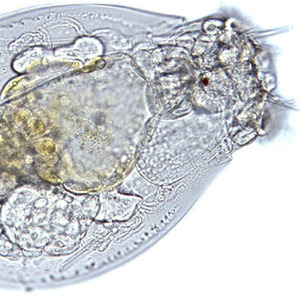Project aims to use probiotic bacteria to produce algal crops




Microscopy UK
July 24, 2015
BY Lawrence Livermore National Laboratory
A Lawrence Livermore team has received an additional $1 million to protect algal crops by developing “probiotic” bacteria to combat pond infestation and increase ecosystem function and resilience.
Algal biomass can be converted to advanced biofuels that offer promising alternatives to petroleum-based diesel and jet fuels. Additionally, algae can be used to make a range of other valuable bioproducts, such as industrial chemicals, biobased polymers and proteins.
Annual productivity is a key metric for algal biofuel production that, if optimized, could significantly decrease and stabilize biofuel price per gallon. Since grazers can result in a 30 percent loss in annual biomass productivity, a consistent mechanism for preventing predators will increase productivity and in turn decrease biofuel cost per gallon.
“We are only just beginning to understand that the pond microbiome is not only an indicator of health but also a tool for crop protection,” said Rhona Stuart, one of the team members from LLNL.
Advertisement
Advertisement
The goal of the project is to identify and employ “probiotic” bacteria to increase microalgal survival by two-fold when under attack by rotifers or chytrids in mass algal cultures.
Rotifers and chytrids are common culprits of algae grazing. By using probiotic bacteria to increase algal resistance against these grazers, the team estimates at minimum a 5 percent to 10 percent increase in annual productivity. The proposed tool has several advantages over the baseline, including minimal risk of pest evolution, tailored microbiome diversity to increase ecosystem resilience and productivity, and probiotics that can increase algal productivity and outgrow pests.
The proposed work also will contribute to overcoming the barrier that exists in translating laboratory success to open pond success by developing methodologies for translating microbiome work from bench scale to process development.
The team is led by Michael Thelen of LLNL and other participating institutions are Heliae Development, LLC, Sandia National Laboratories, UC Davis, and DOE’s Joint Genome Institute. Other members of the LLNL team are Rhona Stuart and Xavier Mayali.
Advertisement
Advertisement
The funding came from the Department of Energy’s Office of Energy Efficiency and Renewable Energy.
Related Stories
The U.S. Department of Energy Bioenergy Technologies Office (BETO) announced up to $23 million in funding to support research and development (R&D) of domestic chemicals and fuels from biomass and waste resources.
The U.S. DOE has announced its intent to issue funding to support high-impact research and development (R&D) projects in two priority areas: sustainable propane and renewable chemicals and algal system cultivation and preprocessing.
Sens. Sherrod Brown, D-Ohio, and Pete Ricketts, R-Neb., in August introduced the Renewable Chemicals Act, a bill that aims to create a tax credit to support the production of biobased chemicals.
The Chemical Catalysis for Bioenergy Consortium, a consortium of the U.S. DOE’s Bioenergy Technologies Office, has launched an effort that aims to gather community input on the development of new biomass processing facilities.
USDA on March 8 celebrated the second annual National Biobased Products Day, a celebration to raise public awareness of biobased products, their benefits and their contributions to the U.S. economy and rural communities.
Upcoming Events










